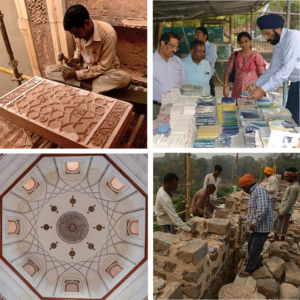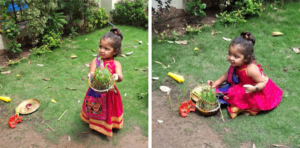
Young voices in heritage is a bimonthly column in our newsletter in collaboration with ESACH (European Students’Association for Cultural Heritage) featuring young people’s perspectives on cultural heritage.
Heritage as a field has always inspired and fascinated me for the kind of diversity that it withholds. I have spent the past few years attempting to map the diversity of my country’s cultural legacy and going beyond the confines of the tangible and built environment. Looking at the success of conservation projects like Nizamuddin Urban Revival, heritage for me became a platform to shed conservative ideologies and come together for an inclusive future.
But in an attempt to romanticise this idea and to promote what I believed Heritage could be, I realised that I had kept myself on this pedestal in these ‘woke’ times and had been oblivious to my own personal heritage and identity. I wanted to believe that I was a person who was not defined by caste or religion. Although I didn’t realise it at the time, the same thing that I thought made me a more sensitive human would become my Achilles’ heel.
Being an emerging professional in the field of heritage, I thought it would aid me in taking a more neutral approach. Unfortunately, while documenting the rural heritage for a recent project, I realised that my lack of knowledge of my own background and customs limited my ability to produce a comprehensive output.
Despite reading numerous papers and books on the issue, I was unable to obtain more accurate information. It was then that I realised that unless I connect with my own heritage, I will not be able to extract information from others about their heritage since, at the end of the day, a checklist and planned set of questions will only take you so far.

Nizamuddin Urban Renewal Inititive. Photo: Aga Khan Trust
And hence, I began to understand my own family’s customs and legacy. In the process, I realised that sometimes rituals aren’t particularly glorious, attractive, or even rational, but they are still our inheritance and our heritage and they connect us with our communities which is essential, especially in this ever-changing century.
One such example is the festival of Gauro. If anyone has seen even one of the super hit Bollywood movies, they must be aware of the ‘Karwa Chauth’ ka vrat celebrations. Gauro and Vrat are based on a similar concept. Very recently one of my young nephews undertook the fast of Gauro and looking at her, made me reminisce about my own celebrations of these fasts.
Gauros are a form of a fast that unmarried young girls participate. It is performed to obtain the Kuldevi’s (an ancestral tutelary deity) blessings It is believed that keeping this fast will ensure a good life partner in the future.
The Gauri Vrat begins on the Shukla Paksha (Lunar cycle) Ekadashi tithi (11th day) of the Asadh month of the Gujarati calendar (July-August) and ends after five days on the day of Guru Purnima.
In this ritual, a dish of pooja is prepared a day before the fasting. The dish comprises of 5 sticks of bamboo, abil-gullal (a type of coloured powder), kanku (red turmeric powder, considered auspicious), akshat (rice) and kharek (dried date). The fast continues for 5 days. The girls are not allowed to eat anything containing salt, oil or other spices. One can only eat a meal one time throughout the day. Thus, the meal usually consists of Rajgara ni roti, dahi and sheero. Although, one can eat fruits or dry fruits throughout the day.

A young girl performing Gauro pooja. Photo: Khushi Shah
Every morning the girl wakes up at the time of sunrise and completes the pooja by 7 o’clock. The pooja is performed in the courtyard or in the garden. The first step of the pooja is called ‘Khetar Khedvu‘. The first bamboo stick is placed inside the mud. The red thread known as Nadachadi is placed over it. One sopari (areca nut) is also kept beside it. Kanku and chokha (rice) are offered over the sopari (areca nut) and bamboo stick. A prayer is then sung which denotes the end of pooja of the first day. Similarly, the same pooja is performed all five days. At the end of the 5th day, 5 sticks are dug in the mud.
A Jagran is also held on the last day of the Gauro. The term “jagran” refers to a gathering of all the girls who have participated in the fast and who will stay up until the morning to complete the fast. The jagran is a very important element of the fast. It is an occasion for all the girls to gather together and spent all night, I couldn’t help but wonder if this was my ancestor’s method of a night out/stay overs.
As I started retracing my own heritage, I discerned a fundamental aspect of these rituals. Even while there are numerous customs and celebrations that don’t make sense in the modern world, one cannot judge merely from the lens of today. These festivals and rituals, which are frequently larger than us, are what bind us to our communities. It enables us to take part in one another’s celebrations and establishes a channel for communication.
Each ritual and festival in my community consists of gatherings and large-scale processions. We are all aware that humans are social creatures, whether introverts or extroverts, all of us as a society thrive together. These events aim to foster dialogue while also offering a diversion from the monotonous routine of daily life. They serve as a gentle reminder that we are not and do not have to be alone.
While documenting several such rituals of my family, I truly realised I came to understand the importance of heritage in our lives.
As part of the religious heritage, these rituals helped me reassess my perspectives and provided me with the chance to reflect on who I am, go deeper into my past, and form strong bonds with those around me.
By Khushi Shah





Follow us: